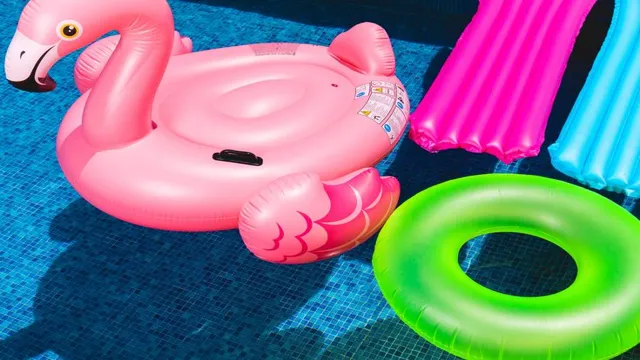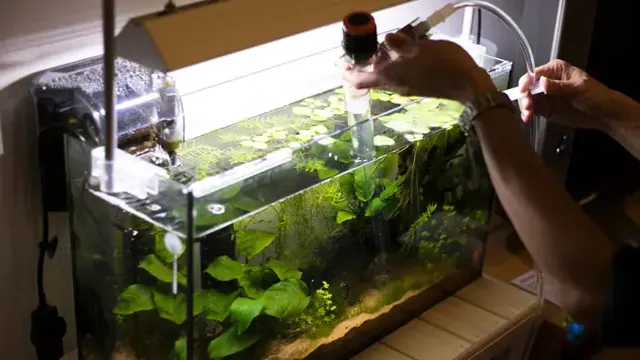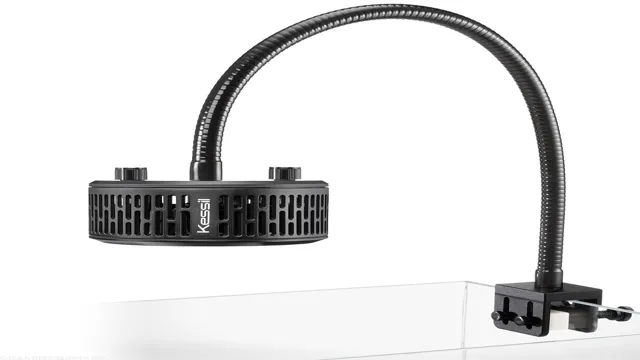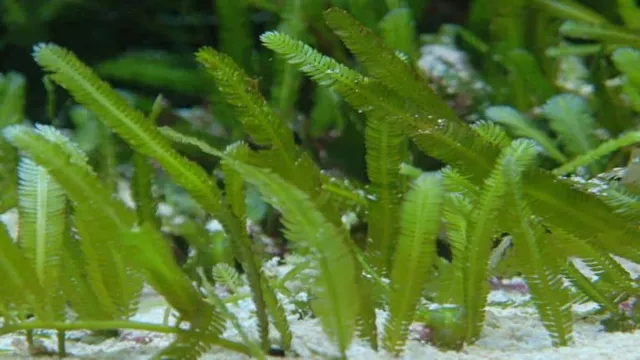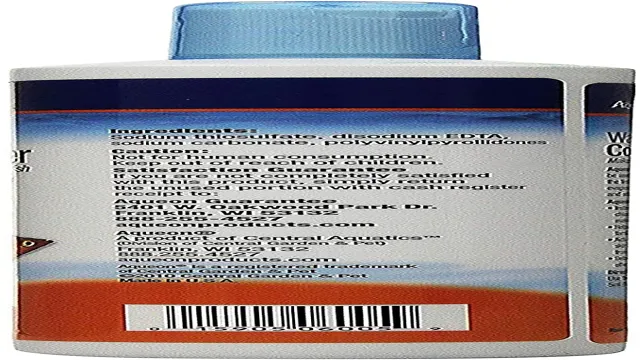Have you ever wondered how to make things float in an aquarium? Maybe you’d like to create an underwater scene, or perhaps you want to add some visual interest to your fish tank. Whatever your reason, there are plenty of ways to achieve the desired effect. One option is to use foam or cork to create a floating platform.
Simply cut it to the size you want and anchor it to the bottom of the tank. Then, attach your chosen items to the platform using fishing line or a similar method. This will allow them to float on the surface of the water and provide a visually stunning effect.
Another option is to use a weighted object to suspend items in the water column. This can be accomplished by attaching weights to a clear fishing line and attaching it to the bottom of the tank. Then, attach your chosen objects to the line at varying heights to create the desired effect.
No matter which method you choose, remember to consider the needs of your fish and other aquatic animals. Make sure the objects you use are safe and won’t harm your pets, and always monitor the water quality to ensure a healthy environment. With a little creativity and some careful planning, you can create a beautiful and captivating underwater display in your aquarium.
Introduction
Are you looking for ways to make things float in your aquarium? Perhaps you want to add some decorative elements, such as flowers or figurines, to your aquatic environment. Or maybe you want to create the illusion of underwater levitation for your fish or other aquatic creatures. Either way, there are a few simple techniques you can use to achieve this effect.
First, consider using lightweight objects that are naturally buoyant, such as plastic or foam materials. You can also create floating devices using suction cups, fishing line, or mesh screens. Alternatively, you can use air pumps or other equipment to create underwater currents that will keep your objects suspended.
With a little creativity and experimentation, you can make your aquarium a stunning underwater oasis that your fish and guests will love.
Why Make Things Float?
Floating objects have always fascinated us – from balloons to ships, we’ve been exploring the science behind making things float for centuries. But have you ever wondered why? Why do we even bother making things float? The simple answer is that it allows us to transport goods and people across bodies of water without them sinking to the bottom. But the concept of making things float goes beyond just transportation – it also plays a significant role in science, engineering, and even arts and crafts.
In this blog section, we’ll explore the different reasons why making things float is important and the ways in which it is used across various fields. Main Keyword: Making things float
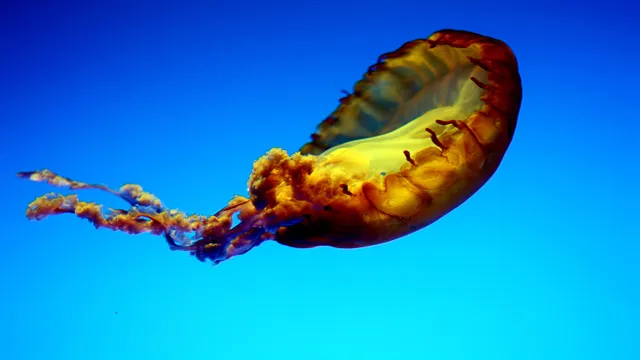
What You Need
When it comes to starting a new venture, having the right tools and resources can make all the difference. Whether you’re starting a new business, embarking on a creative project, or pursuing a personal goal, there are a few key things you’ll need to get started. First and foremost, having a clear idea of what you want to accomplish is essential.
From there, you’ll need to do some research to figure out what resources are available to you. This might include things like books, online courses, mentors, or networking events. You’ll also need to consider what tools you’ll need to bring your idea to life.
Depending on your project, this might include equipment, software, or physical materials. Finally, it’s important to have a plan in place to stay organized and on track. By taking the time to identify what you need upfront, you’ll be setting yourself up for success in the long run. (See Also: How to Determine Aquarium Gallons: A Beginner’s Guide to Measuring Tank Capacity)
Types of floating objects to use
If you’re looking to add some floating objects to your aquarium, there are a few different types you can choose from. Plants are a popular choice, as they not only add visual interest but can also provide hiding spots for fish. Just keep in mind that not all plants are suitable for floating, so do your research before adding them to your tank.
Another option is to use objects like moss balls or driftwood, which can create a natural and organic look in your aquarium. If you’re feeling crafty, you can even make your own floating objects using materials like cork or foam. Whatever you choose, make sure it’s safe for your aquatic inhabitants and won’t disrupt the balance of your tank’s ecosystem.
With a little bit of creativity, you can easily add some floating objects to your aquarium and create a beautiful underwater world. So, go ahead, make your aquascape stand out by using these simple tips and make things float in your own aquarium.
Aquarium-safe Materials
As a fish owner, you might want to spruce up your aquarium with some floating objects. However, not all materials are safe for your aquatic pets. The good news is that there are plenty of options available that are aquarium-safe.
You can use plastic plants, cork, and even certain types of wood. Plastic plants are easy to find and come in a variety of colors and sizes, and they won’t harm your fish. Cork is another great option that naturally floats and can easily be shaped to create a natural-looking environment for your fish.
And if you’re looking for a natural alternative, certain types of wood like driftwood can also be used as long as they have been properly cleaned and treated beforehand to ensure they are safe for your aquarium. With these options, you can add some depth and variety to your aquarium while ensuring the safety and well-being of your fish.
Natural Floating Objects
When searching for natural floating objects to use, it’s important to consider the type that will work best for your specific needs. Some common types include driftwood, dried gourds, and even seashells. Driftwood is great for adding a rustic touch to your decor, while dried gourds offer a unique shape and texture.
If you’re looking for something with a bit more color, seashells come in a variety of shapes and sizes and can be easily incorporated into any design. Whatever type of natural floating object you choose, make sure to clean it thoroughly before use to ensure it’s safe for both you and your aquatic pets. By utilizing these natural materials, you can create a beautiful and environmentally-friendly aquatic environment.
Artificial Floating Objects
If you’re looking to add some unique decor to your pool or lake area, you might want to consider artificial floating objects. There are several types to choose from, so you can find something that matches your style. One popular option is a floating planter, which can hold live plants and add a touch of greenery to the water.
Another option is a floating sculpture or art piece, which can be a fun and eye-catching addition to your space. For those who enjoy relaxation, you can invest in a floating lounger or even a floatable bar to enjoy drinks while soaking up the sun. Whatever your preference, artificial floating objects are a great way to add something extra to your aquatic experience.
So why not take the plunge and give it a try?
Safe Floating Techniques
If you’re wondering how to make things float in your aquarium, there are a few safe techniques you can use. First and foremost, it’s important to choose objects that won’t harm your fish or disrupt the balance of your tank. Lightweight materials like styrofoam or cork can be attached to items like plants or decorations to create a floating effect. (See Also: How to Clean Acrylic Aquarium Without Scratching: Tips and Tricks)
Another option is to use suction cups or fishing line to suspend objects in the water. If you’re looking for a more natural approach, some aquatic plants naturally float on the water’s surface and can be a great addition to your tank. Whatever method you choose, be sure to monitor the floating objects closely and remove anything that poses a risk to the health and safety of your aquatic pets.
With a little creativity and caution, you can easily create a stunning floating display in your aquarium.
Balancing the Object
When it comes to safe floating techniques, balancing the object is crucial to ensure stability in the water. Whether it’s a person, a boat, or any other floating device, maintaining equilibrium is key to avoid capsizing or accidents. One effective way to balance an object in the water is by shifting the weight towards the center.
This can be done by adjusting the position of the passengers and cargo, and by redistributing the weight as needed. Additionally, making sure that the object is properly inflated or loaded can also help ensure stability. Always remember to follow safety guidelines, wear personal flotation devices, and practice caution when navigating the water.
By balancing the object and taking necessary precautions, you can enjoy a safe and fun time on the water.
Using Nylon Thread or Fishing Line
When it comes to creating safe floating techniques, using nylon thread or fishing line is a great option. These materials are strong, durable, and can withstand various weather conditions. Nylon thread is particularly popular because it is resistant to abrasion and has a high breaking strength.
Additionally, it is not affected by water, making it an ideal choice for water-based projects. Fishing line is also a great option because it is tough and can withstand the weight of the object being floated. However, it is important to note that when using fishing line, it is imperative to tie it securely to the object being floated to prevent entanglement or harm to marine life.
Overall, regardless of the material chosen, it is important to always prioritize safety and adhere to responsible boating practices to ensure a positive and enjoyable experience on the water.
Creating a Floating Platform
Creating a floating platform can be a fun and exciting project, but it’s important to prioritize safety throughout the process. One important technique is to ensure that the platform is well-balanced and stable, with equal weight distribution across all sides. This can be achieved by using an anchor system, and adjusting it as necessary to maintain balance.
Additionally, incorporating buoyancy aids such as foam blocks or inflatable devices can provide additional stability and ensure that the platform stays afloat. It’s also crucial to pay attention to the weather and water conditions, and avoid constructing or using the platform during particularly turbulent or rough conditions. By taking these steps, you can create a safe and enjoyable floating platform experience for yourself and others.
Conclusion
In conclusion, the art of making things float in a aquarium can be a tricky one. It requires a delicate balance of buoyancy, weight distribution, and creativity. Whether you choose to use live plants, artificial decorations, or even household objects, it is important to consider the overall aesthetic and health of your aquatic environment. (See Also: How to Grow Moss on Aquarium Wall: A Comprehensive Guide for Aquarists)
So, next time you’re looking to add a little flair to your fish tank, remember to keep your creativity afloat and experiment with the various techniques at your disposal. Who knows, with a little bit of luck and a whole lot of imagination, you just might create a floating masterpiece that will make your fish friends swim with envy!”
FAQs
Why won’t my decorations float in my aquarium?
Decorations may not float in an aquarium if they aren’t buoyant enough. To increase buoyancy, try attaching suction cups or adding additional materials to create a more balanced decoration.
Can I make my fish tank plants float?
Yes, you can make fish tank plants float. Use a weighted base and attach the plants to an air stone or foam before carefully placing them in the tank.
How do I make a DIY floating aquarium plant?
To make a DIY floating aquarium plant, you will need a foam ball, suction cups, and an aquatic plant. Attach the suction cups to the foam ball and carefully push the plant through the ball. Finally, attach the suction cups to the aquarium wall.
What materials can I use to make artificial fish tank decorations float?
Artificial fish tank decorations can be made to float by using materials like styrofoam, cork, or plastic bottles. Attach the material to the decoration using waterproof glue or suction cups.
How do I make a floating fish feeder?
To make a floating fish feeder, use a small plastic container or bottle and punch holes in the bottom. Place fish food inside and float the container in the tank.
Why are my floating decorations sinking?
If your floating decorations are sinking, they may be too heavy or improperly balanced. Try adjusting the decoration, or adding additional buoyant materials to correct the issue.
Can I make a floating fish tank divider?
Yes, a floating fish tank divider can be made using materials like mesh or plastic canvas. Cut the material to size and attach suction cups to the top and bottom for stability.

